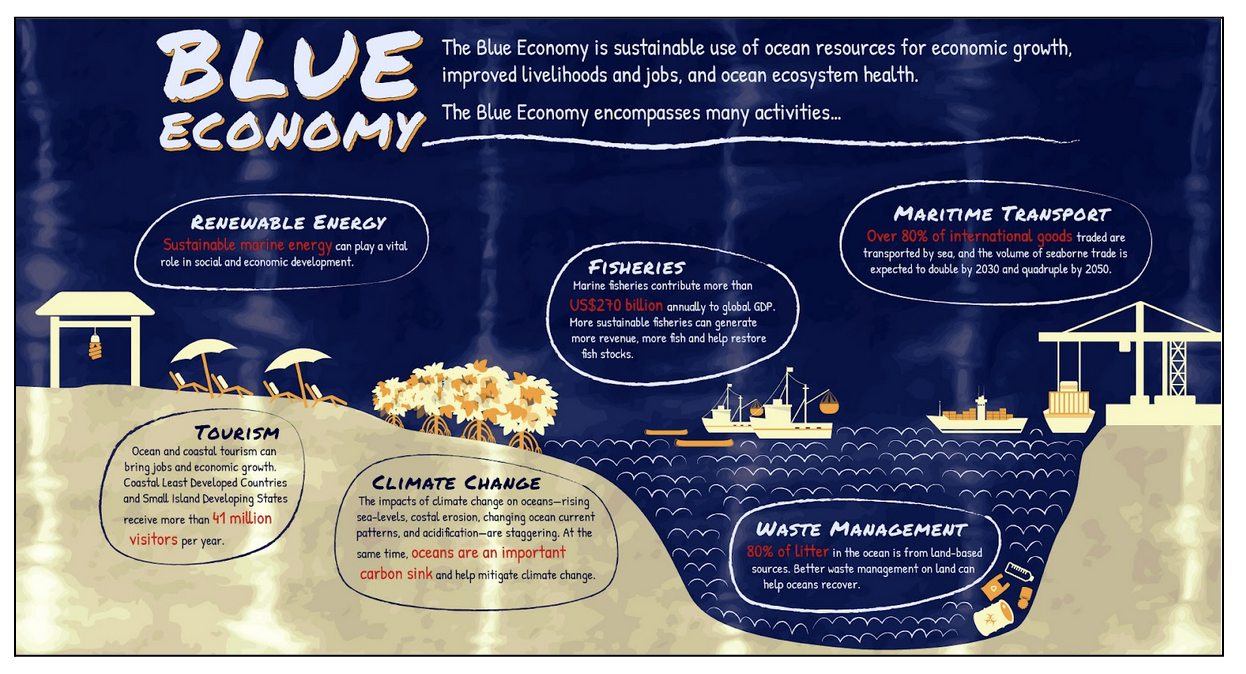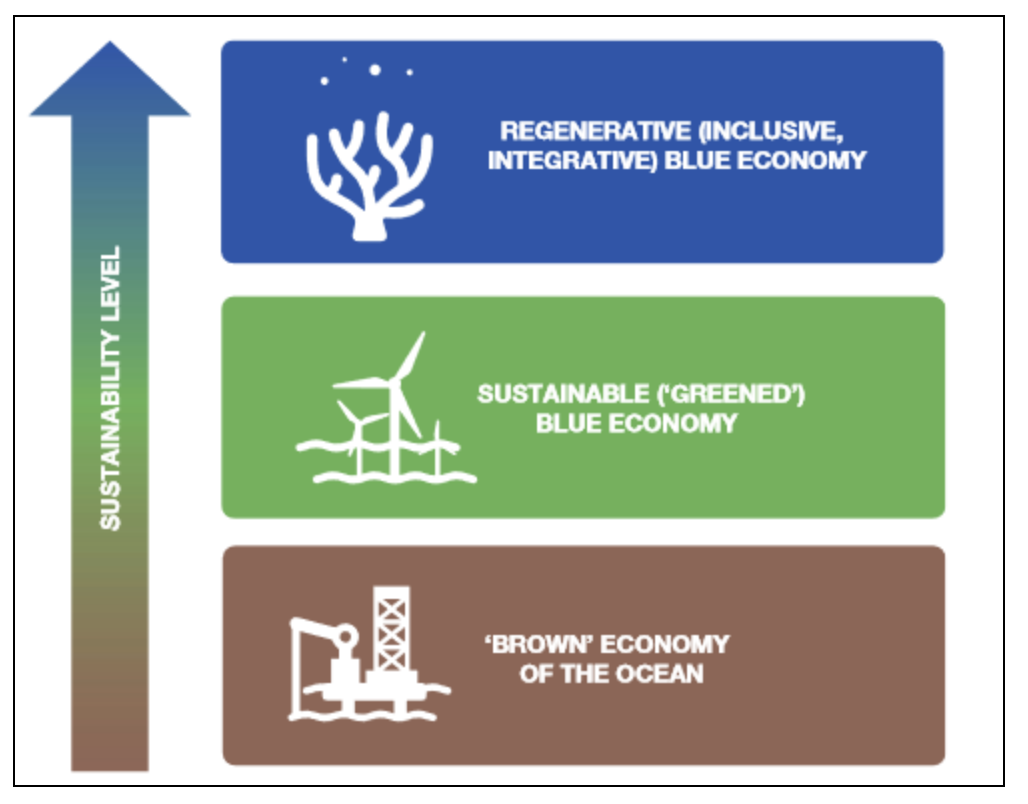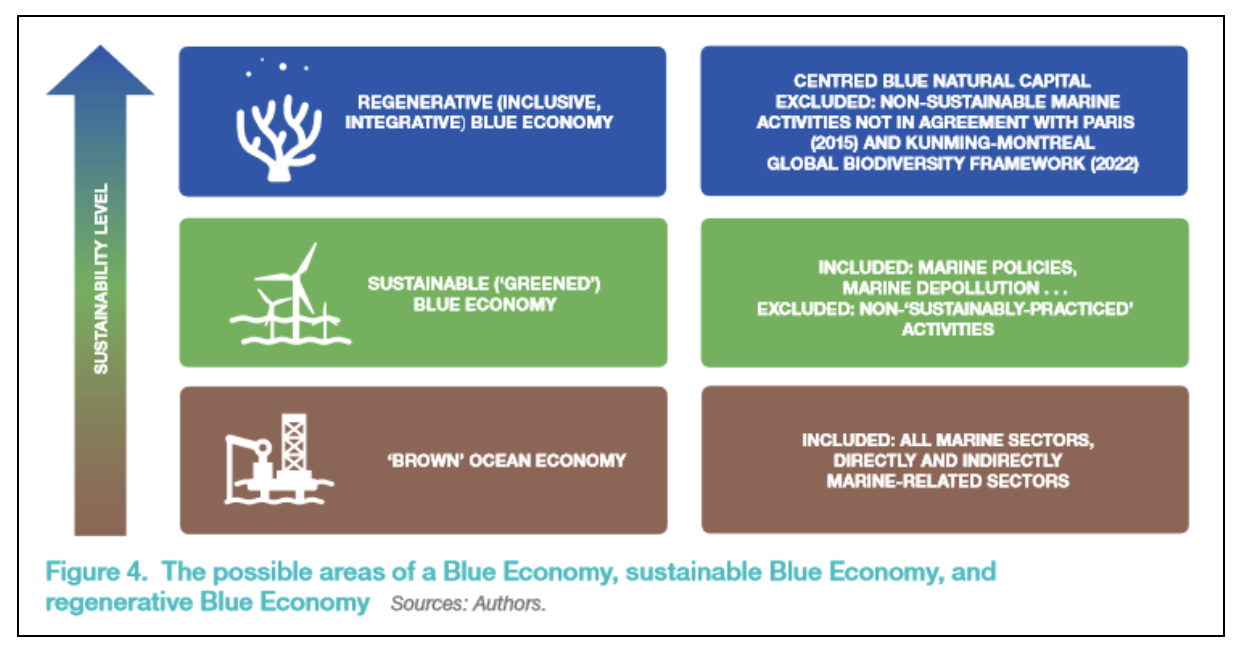GS Paper III
News Excerpt:
The IUCN has recently published a report titled “Towards a regenerative Blue Economy,” outlining a clear definition and founding principles for a “Regenerative” Blue Economy.
More About the News:
- The report came as a joint effort among IUCN Commissions, Secretariat and partners under the France-IUCN Partnership (2021-2024).
- It defines different sustainability levels within the overall umbrella and sets ambitions for nature and society alike.
What is the Blue Economy?
- The blue economy is the "sustainable use of ocean resources for economic growth, improved livelihoods, and jobs while preserving the health of ocean ecosystems.

Types of Blue Economy according to the report:
IUCN report has put forward three types of Blue Economy from a conservation and sustainable development perspective:

1. The 'Brown Blue' Economy:
- A 'Brown Blue' Economy’ is the Blue Economy rooted in the maritime sector.
- It includes traditional activities of the maritime sector. It is anthropocentric and based on a conventional economic model.
2. The Sustainable Blue Economy:
- A Sustainable Blue Economy unlocks multiple environmental, social and economic benefits and drives sustainable development.
- A sustainable blue economy provides essential benefits for current and future generations; restores, protects and maintains diverse, productive and resilient ecosystems; and is based on clean technologies, renewable energy and circular material flows.
3. The Regenerative Blue Economy:
- A Regenerative Blue Economy is inclusive, advocates for ‘blue justice’, and is based on a participatory, transparent, and inclusive governance model, at multiple levels.
- This model is based on the broad principles of the ecosystem approach, respecting the rights of nations and coastal communities.
- In economic terms, a Regenerative Blue Economy seeks robust sustainability, prioritising the preservation of blue natural capital.
- Certain activities, such as oil extraction, are excluded from this scope.
- These activities are considered incompatible with the carbon reduction objectives of the 2015 Paris Agreement.
- They are activities deemed too threatening for marine ecosystems, such as deep-seabed mining (DSM).
- To fall under the scope of the regenerative blue economy, other sectors such as fishing, aquaculture, and tourism will need to adapt their practices.
- Historical evolution of the term “Regenerative Blue Economy”:
- The Pacific Island Countries have been demanding for an improvement to the Blue Economy principles and applications for more than a decade.
- For Small Island Developing States (SIDS), the challenges of protecting and preserving the health of marine and coastal ecosystems, and living marine resources, are critical, as declared in 2009 by the IUCN Oceania Regional Office.
- This need requires a “Regenerative” vision for the Blue Economy, going beyond economic factors to be: integrative, inclusive, and regenerative; advocating for an economic model able to meet global and local challenges.
- To match this model’s vision, the term “Regenerative” has been prepended to “Blue Economy” since 2020.
- Since 2020, this approach has emphasised not just sustainability but also the regeneration of marine ecosystems, aiming to restore and enhance the natural environment.

Key Developments:
- Rio+20 Summit (2012): At the United Nations Conference on Sustainable Development, the "Blue Economy" was defined to include all marine sector economic activities that align with sustainable development principles.
- WWF Proposal (2015): The World Wide Fund for Nature (WWF) introduced a comprehensive vision for a sustainable Blue Economy. This vision emphasised sustainability and inclusivity, moving beyond the traditional, simpler definitions of the Blue Economy.
The potential scope of Regenerative Blue Economy:
- Coastal ecosystems, such as mangroves, tidal marshes and seagrass meadows, sequester and store more carbon per unit area than terrestrial forests and are now being recognised for their role in mitigating climate change.
- These ecosystems also provide essential benefits for climate change adaptation, including coastal protection and food security for many coastal communities.
- However, if the ecosystems are degraded or damaged, their carbon sink capacity is lost or adversely affected and the stored carbon is released, resulting in carbon dioxide (CO2) emissions that contribute to climate change.
- Dedicated conservation efforts can ensure that coastal ecosystems continue to play their role as long term carbon sinks.
Measuring the progress of Blue economy
- Ocean Impact Navigator has been proposed as a way to measure the positive impact on ocean and coastal socio-ecological systems, this indicator evaluates the efficacy of regenerative activities.
- Blue Justice: This approach advocates for fairness and equity, respecting the rights of nations and coastal communities.
Financing arrangements for the Blue Economy:
- Public policies, incentives, taxation, and subsidies play a crucial role in funding the Blue Economy, Sustainable Blue Economy, and Regenerative Blue Economy.
- Financing tools include private investments and public-private partnerships (PPPs).
- International Cooperation:
-
- OECD and World Bank (2020) has evaluated international aid and Official Development Assistance (ODA) for a sustainable Blue Economy.
-
- Asian Development Banks’s proposed approach is also an example of clarifying responsible investments in the marine and coastal ecosystems.
-
- Principles for sustainable blue finance were proposed in 2018 by a consortium including UNEP-FI, WWF, European Commission, World Resources Institute (WRI), and European Investment Bank.
The Blue Economy faces several complex challenges:
- Undefined Scope and Implementation: The scope, principles, and implementation of the Regenerative Blue Economy are still evolving. As research and understanding progress, defining these aspects becomes crucial to ensure effective application.
- Performance Assessment: There is a need for consistent performance assessment tools that align with the principles of the Regenerative Blue Economy. Indicators such as the 'Ocean Impact Navigator' as mentioned, can help evaluate the positive impact on ocean and coastal socio-ecological systems.
- Cross-Sector Sustainability Assessment: Evaluating the sustainability of projects, strategies, or implementations within the Blue Economy, including governance processes at specified geographical levels.
Conclusion:
The Regenerative Blue Economy represents a transformative approach to managing and utilising marine resources. By prioritising ecosystem health, social inclusion, and sustainable practices, it aims to create a resilient and equitable economic model. However, for this vision to be fully realised, there must be clarity and consistency in its definitions, principles, and implementation strategies. As the understanding and research in this field continue to grow, a unified framework will be essential in guiding global efforts towards a truly regenerative blue economy.


